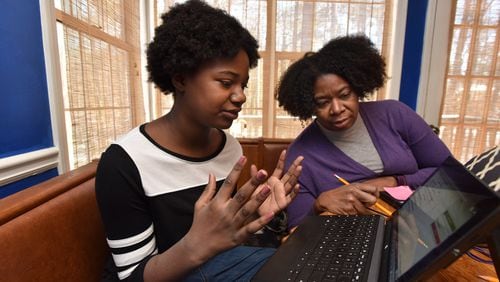With snow and ice keeping Gwinnett County students out of school for two full days last week and causing a delayed start on Friday, the school system put a new program into action. With digital learning days, students can go online to find assignments and communicate remotely with questions and requests for help.
The system is set up so kids can use computers, tablets or smartphones …
Or no technology at all.
In anticipation of the snow days, some teachers prepared students before they left school. The children brought home books and other materials so that even if their power went out, they’d still be able to get in learning time.
Paula Richards-Bell, an eighth-grade language arts teacher at Jordan Middle School, knows firsthand that learning and working from home often means shared resources. With two children of her own, she had to make sure her girls had time for instruction and she had time for her students.
“With two kids and one computer, we had to work in shifts,” she said. “And not everything required the computer.”
Richards-Bell uses an app called Remind to communicate with her students daily.
“They asked me to use the chat feature — I didn’t know it had one,” she said. “After they showed me how easy it was, we began using it all year. We built it into the communication process.”
Making sure teachers and students were comfortable with the program was why Gwinnett didn't rush to roll it out, said school system spokeswoman Sloan Roach.
“Of course we had early adopters, but some teachers weren’t comfortable with the technology,” she said. “We had to introduce them to the program in a way to engage them.”
After seven years of testing it, the program went live. On Jan. 8, when the threat of ice and frigid temperatures caused many to close school, Gwinnett students, staff and administrators got their first taste of digital learning.
In a report to the school board Thursday, assistant superintendent Jonathan Patterson along with assistant superintendent Steve Flynt and chief information officer Frank Elmore gave preliminary findings about how it is working so far.
Elmore said the system had slow periods but never crashed.
“We had about 155,000 people on the system at its peak and that put the server at 60 percent of its capacity,” he said adding that he’s comfortable that the support portal can be pushed to as high as 80 percent and still function effectively.
Part of the success was probably because all students didn’t sign on at once. The program is set up so there is an hour interval between high school, elementary and middle school students logging in.
Richards-Bell said the support behind the scenes was evident.
“We had some students who had trouble staying logged on. We told them to log off and back on again and the system caught up,” she said. Wednesday “ran very smoothly and I expect it will only get better as everyone gets more comfortable with it.”
In wrapping up his assessment Thursday, Flynt concurred.
“The plan worked well because the teachers and principals planned well,” he said. “Through assessments and feedback we furthered our understanding and broadened relationships between students and teachers, students and students and teachers and teachers.”
And the costs were negligible, the district says. “In fact, related to costs, there are savings in some areas (utilities, fuel/transportation, etc.) when a Digital Learning Day is implemented,” said Roach.
"School systems have long been given forgiveness for missed school days due to weather. We feel digital learning days are a much better solution than just closing and not making up the missed instruction," said Roach. "It is a hardship to make up missed school days and digital learning days make it easier for us to ensure 180 days of instruction for students."
Over the two days, Richards-Bell said she communicated directly with about 96 percent of her 103 students.
“The ones that needed me were able to get me,” she said. “It’s about meeting them where they are and keeping them engaged in work that makes sense.”
Gwinnett school administrators are looking at more ways to incorporate digital learning into the curriculum, but believe nothing beats face-to-face interaction.
“The quality of the assignments and the instruction matters,” said Flynt. “You don’t want to assign something on a digital learning day that you wouldn’t any other day. … We’re preparing them for the rest of their lives, and technology will be a part of that.”







